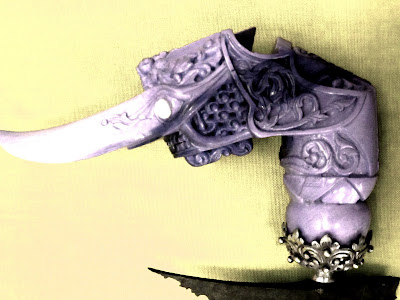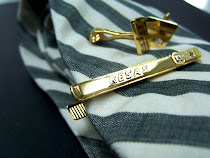 The Keris is unique in form and function. It is at once a beautiful work of art and a menacing implement of war. A keris is usually equipped with a hilt (hulu), a dongkok (a metal cup at the base of the hilt) and a sheath (sarung). This special keris was given by a great keris collector in Alor Star for me to refurnish it with metals parts and fittings.
The Keris is unique in form and function. It is at once a beautiful work of art and a menacing implement of war. A keris is usually equipped with a hilt (hulu), a dongkok (a metal cup at the base of the hilt) and a sheath (sarung). This special keris was given by a great keris collector in Alor Star for me to refurnish it with metals parts and fittings. Almost all old keris Melayu have hilts in a design known as "ayam teleng". The hilt is held at an angle with the blade, which gives it a horizontal stabbing position. This is ideal for stabbing an opponent in the chest area as the position allows the blade to pass between the ribs and straight to the lungs or heart. This feature also serves certain ritualistic functions.
Almost all old keris Melayu have hilts in a design known as "ayam teleng". The hilt is held at an angle with the blade, which gives it a horizontal stabbing position. This is ideal for stabbing an opponent in the chest area as the position allows the blade to pass between the ribs and straight to the lungs or heart. This feature also serves certain ritualistic functions.  Below is the picture of the hilt part which had been covered by metal at the nose part of it.
Below is the picture of the hilt part which had been covered by metal at the nose part of it.
 The blade of this keris was made off old metal. Usually it is forged from at least three types of metal, including iron and nickel to make the blade strong and sharp. Some of the older blades are even springy and do not break easily. However, keris blades are often brittle, and may break if hit with another weapon. The blade is the most important part of a keris.
The blade of this keris was made off old metal. Usually it is forged from at least three types of metal, including iron and nickel to make the blade strong and sharp. Some of the older blades are even springy and do not break easily. However, keris blades are often brittle, and may break if hit with another weapon. The blade is the most important part of a keris. The Blade parts itself translated a lot meanings, all parts have it own names and functions, it was designed with detail and very deep in value. The blade of the keris represents the shape of a dragon, which is closely connected to water and rivers. Water is the source of life, thus the dragon is a mystical life form that represents power. A keris with no waves represents a resting or meditating dragon, while a wavy keris represents a moving dragon. The 'belalai gajah' and 'lambai gajah' represents and elephant, which is an allegory for power.
The Blade parts itself translated a lot meanings, all parts have it own names and functions, it was designed with detail and very deep in value. The blade of the keris represents the shape of a dragon, which is closely connected to water and rivers. Water is the source of life, thus the dragon is a mystical life form that represents power. A keris with no waves represents a resting or meditating dragon, while a wavy keris represents a moving dragon. The 'belalai gajah' and 'lambai gajah' represents and elephant, which is an allegory for power.
 The 'Sampir' (crosspiece) of this keris is made from an kemuning wood, and it houses the wide part of the blade. The below picture is the metal fitting that had been done to fit between the 'sampir' and the 'batang' parts.
The 'Sampir' (crosspiece) of this keris is made from an kemuning wood, and it houses the wide part of the blade. The below picture is the metal fitting that had been done to fit between the 'sampir' and the 'batang' parts.
 Below is the 'batang' part which is the main housing for the blade. The 'batang' usually made of sena wood. However this part was nicely covered with metal linings which enhancing this long part of wood.
Below is the 'batang' part which is the main housing for the blade. The 'batang' usually made of sena wood. However this part was nicely covered with metal linings which enhancing this long part of wood. Below is the 'buntut' (end) part of the keris, it was made of different kind of wood which is called 'Kemuning Hitam'. From my own point of view this part should not being covered by metal carving as it has it's own specialty, so i decided to cover only from the upper part of it.
Below is the 'buntut' (end) part of the keris, it was made of different kind of wood which is called 'Kemuning Hitam'. From my own point of view this part should not being covered by metal carving as it has it's own specialty, so i decided to cover only from the upper part of it.  Below picture was taken after it was perfectly done. The 'buntut' protects the end of the sheath and also as a butt cap.
Below picture was taken after it was perfectly done. The 'buntut' protects the end of the sheath and also as a butt cap.
 The picture below is Mr. Rosli Tahir, he is the silversmiths of this keris parts. He is one of the silversmiths in Kota Bharu Kelantan. Mr. Rosli Tahir or known as Pok Li had been in silversmiths industry since 1950, and one of the earliest members of 'Kelantan Malay Art' which is now undertaken by 'Kraftangan Malaysia'.
The picture below is Mr. Rosli Tahir, he is the silversmiths of this keris parts. He is one of the silversmiths in Kota Bharu Kelantan. Mr. Rosli Tahir or known as Pok Li had been in silversmiths industry since 1950, and one of the earliest members of 'Kelantan Malay Art' which is now undertaken by 'Kraftangan Malaysia'. Pok Li is a professional in traditional silver carving, his workmanship is very fine and the art of his carving has its own identity and specialty. Below he showed me some of his sketches for me to decide how to decorate the fittings of this keris.
Pok Li is a professional in traditional silver carving, his workmanship is very fine and the art of his carving has its own identity and specialty. Below he showed me some of his sketches for me to decide how to decorate the fittings of this keris. This is before this keris had been enhanced with metals finish and fittings.
This is before this keris had been enhanced with metals finish and fittings. From below picture you can see after it was greatly done by Pok Li.
From below picture you can see after it was greatly done by Pok Li.
 Today the keris is depicted as a symbol, it can be seen on an obverse copper-zinc-tin RM1 coin with a songket pattern in the background. Since the independence of Malaysia, the keris has become something of a symbol of Malay Nationalism. It is still regarded by some as a symbol of Ketuanan Melayu, the doctrine of Malay as the dominant race. However it is up to us the new generations to take our part to maintain this valuable symbol for the next 1000 years. Thanks for visiting my blog and very happy to have such a great follower here!
Today the keris is depicted as a symbol, it can be seen on an obverse copper-zinc-tin RM1 coin with a songket pattern in the background. Since the independence of Malaysia, the keris has become something of a symbol of Malay Nationalism. It is still regarded by some as a symbol of Ketuanan Melayu, the doctrine of Malay as the dominant race. However it is up to us the new generations to take our part to maintain this valuable symbol for the next 1000 years. Thanks for visiting my blog and very happy to have such a great follower here!Read more...

 It is so interesting when we had a chance to learn how to canting a batik. By a help from a professional batik maker Mr.
It is so interesting when we had a chance to learn how to canting a batik. By a help from a professional batik maker Mr.  The one day canting class was held in
The one day canting class was held in  First step of learning process in batik was sketching motives as flowers.
First step of learning process in batik was sketching motives as flowers.
 Then they should know how to handle and use canting.
Then they should know how to handle and use canting.  Its quite easy when Mr.
Its quite easy when Mr. But then to try your 'first time canting' should be on a paper!
But then to try your 'first time canting' should be on a paper! Then they go on real cotton.
Then they go on real cotton. I was really surprise to see the participants were so easy doing the canting.
I was really surprise to see the participants were so easy doing the canting.  can you believe it was their first time?
can you believe it was their first time? Now goes to the best part, which is coloring!
Now goes to the best part, which is coloring! They learned so fast
They learned so fast  And now I can see that they love doing canting.
And now I can see that they love doing canting. Just see the result. How they are so passion in canting their own batik.
Just see the result. How they are so passion in canting their own batik.


 Finally we end up like this! Not a good work, just a good try for a first time learner!
Finally we end up like this! Not a good work, just a good try for a first time learner!














